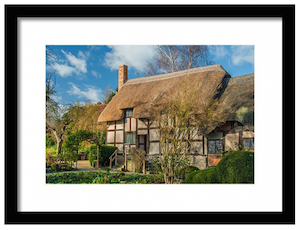
The medieval church of St Margaret, Paston, dates to the 14th century and was built on a pilgrims' route linking Bronholm Priory with a chapel at Stow Hill.
The church is closely linked to the Paston family, who lived in the adjoining Paston Hall (now vanished). The Pastons are famous for a collection of letters written between family members, revealing a wealth of details about life in medieval and Tudor England.
Most of the medieval and Tudor Pastons were buried at nearby Bronholm Priory, and St Margaret's Church was left relatively simple and plain by comparison.
The Paston family seat moved to Oxnead in 1597 and Paston Hall was left to decay. The Tudor cellars are now incorporated into the current 19th-century residence that stands west of the churchyard.
The church is built of flint and chert with limestone ashlar dressings. The chancel is roofed with tiles but the nave is protected by a thatch roof.
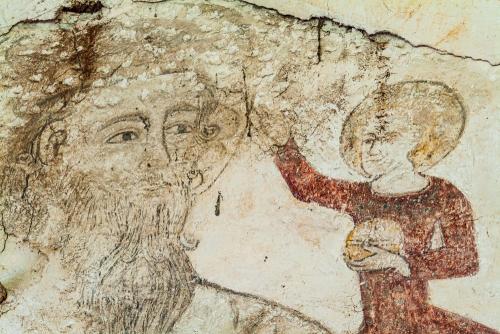
Wall Paintings
Paston church is known for its outstanding 14th-century wall paintings. The largest of these shows St Christopher carrying the Christ child across a river, a scene often painted facing the main entrance to a church. The other major painting depicts the Biblical 'Three Living and Three Dead', a reminder of mortality.
In 2013, repairs to the chancel arch revealed more wall paintings dating to the middle of the 15th century. These paintings depict an angel with a censer and symbols of the Passion.
The Paston Letters
St Margaret's Church is closely linked to the Paston family. The Pastons, who rose from humble beginnings to become significant landowners in Norfolk, played a crucial role in the social and political landscape of 15th-century England.
More importantly, the family's extensive collection of letters is a treasure trove for historians, providing unprecedented insights into medieval domestic life, political intrigue, and social dynamics. The Paston Letters cover the period from 1422 and 1509 and are among the most important primary sources of material for historians and linguistic scholars.
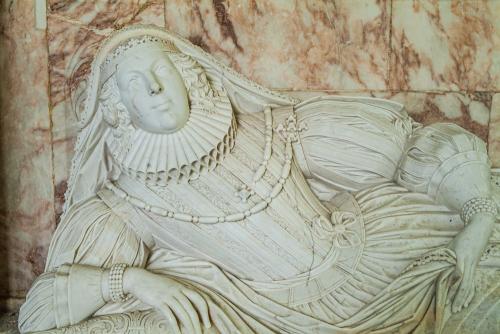
Many of the letters were written by Margaret Paston (d. 1484) to her husband, John Paston, a lawyer who spent much of his time in London. The letters convey a wealth of information on day to day life in late medieval England, with commentary on the ever-shifting political and social climate of the time. The Letters were the inspiration for Robert Louis Stevenson's novel, The Black Arrow, published in 1888.
The majority of the Paston Letters are held in the British Library, but there are also letters at the Bodleian Library in Oxford, Magdalen College, Oxford, and Pembroke College, Cambridge.
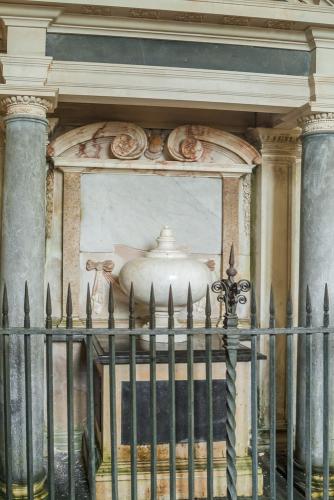
The Paston Monuments
In the chancel are a pair of opulent memorials to members of the Paston family. The more impressive of the two monuments commemorates Katherine Knyvet Paston, wife of Sir Edmund Paston (d. 1628). The memorial is the work of Nicholas Stone, who served as the Master Mason to King Charles I.
The epitaph was composed by John Donne, then Dean of St Paul's Cathedral and later to gain fame for his metaphysical poetry. The alabaster and marble memorial features a superbly carved white marble effigy of Lady Katherine in a reclining position, attended by several allegorical figures.
Nicholas Stone was also responsible for the second memorial, to Sir Edmund Paston (d. 1632). In this case, there is no effigy, only a stone urn set within Doric columns.
Both Paston tombs stand behind iron railings installed in 1632.
Also in the chancel are three tomb chests. The most easterly chest is likely to be that of John Paston (d. 1466). To the south of the altar is a 13th-century sedilia with an angle piscina. The communion rail is thought to date to the 17th century.

The east window is in memory of John Mack of Paston Hall (d. 1867). It is thought to be the work of the prestigious stained-glass firm of Clayton and Bell. In the south aisle is a memorial window commemorating Ralph Mack, a Lieutenant Commander of the Royal Navy, who died when his ship, the HMS Tornado, struck a mine off the coast of Holland in 1917.
Other historical highlights include a 15th-century reading desk with poppyhead decoration and a 14th-century font. The screen dates to the 15th century but it has been heavily restored. over the tower arch is a royal coat of arms dated to 1831.
The pew ends are well worth exploring. One features the Paston coat of arms and the family crest, a griffon (also spelled gryphon or griffin). Another pew end depicts a devil sticking out his tongue.
An extraordinary recent find at Paston Church was a 15th-century manuscript found hidden in the doorway to the medieval rood loft. The manuscript bears notation for part of a medieval antiphon, or liturgical chant. The antiphon was deciphered and sung in a special ceremony in the church.
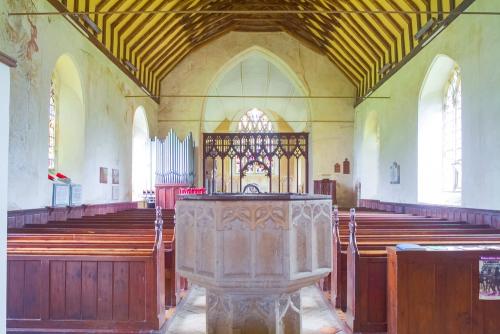
The Lych Gate
A stroll around the Paston churchyard leads you to a historical anomaly. The lych gate and entrance porch are on the south side of the church, but the lych gate leads into an area of woodland where you can see traces of a long-lost roadway, now forgotten.
The reason for this odd arrangement goes back centuries, when the main road through Paston ran directly past Paston Hall, between the hall and the churchyard. Sir William Paston objected to people passing directly in front of the hall on their way to church services, so he had the road moved to the other side of the churchyard, where it runs today.
The Pastons kept their privacy but local residents were irate. They knocked down the wall that Sir William built to block the road, only for him to rebuild it. This pattern repeated several times, with residents destroying the wall and Sir William rebuilding it.
Immediately opposite the church is the Paston Great Barn, an impressively large thatched barn built for the Paston family in 1581.
Visiting
St Margaret's Church stands on the B1159 (Bacton Road). There is a small parking area outside the church gates. The church is regularly open to visitors and was open when we visited.
About Paston, St Margaret's Church
Address: Bacton Road,
Paston,
Norfolk,
England, NR28 9TA
Attraction Type: Historic Church
Location: On Bacton Road (the B1159). Parking outside the church drive.
Website: Paston, St Margaret's Church
Location
map
OS: TG322344
Photo Credit: David Ross and Britain Express
HERITAGE
 We've 'tagged' this attraction information to help you find related historic attractions and learn more about major time periods mentioned.
We've 'tagged' this attraction information to help you find related historic attractions and learn more about major time periods mentioned.
Find other attractions tagged with:
14th century (Time Period) - wall painting (Historical Reference) -
NEARBY HISTORIC ATTRACTIONS
Heritage Rated from 1- 5 (low to exceptional) on historic interest
Edingthorpe, All Saints - 0.8 miles (Historic Church) ![]()
Knapton, St Peter & St Paul Church - 1 miles (Historic Church) ![]()
Trunch, St Botolph - 2.2 miles (Historic Church) ![]()
Honing, St Peter & St Paul - 4 miles (Historic Church) ![]()
Happisburgh, St Mary's Church - 4.1 miles (Historic Church) ![]()
East Ruston, St Mary's Church - 4.3 miles (Historic Church) ![]()
East Ruston Old Vicarage Garden - 4.3 miles (Garden) ![]()
Happisburgh Lighthouse - 4.5 miles (Historic Building) ![]()
Nearest Holiday Cottages to Paston, St Margaret's Church:
More self catering near Paston, St Margaret's Church



